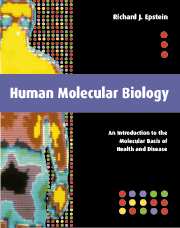Book contents
- Frontmatter
- Contents
- Preface
- Acknowledgements
- Read me first …
- Glossary
- Dedication
- Introduction: A disease for every gene?
- I From molecular biology to human genetics
- II From molecular genetics to human biochemistry
- III From molecular biochemistry to human cell biology
- IV From molecular cell biology to human physiology
- V From molecular physiology to human molecular biology
- 21 Genetic experimental systems
- 22 Gene and protein analysis
- 23 Genetic engineering, gene mapping, and gene testing
- 24 Gene knockouts, transgenics, and cloning
- 25 Gene therapy and recombinant DNA technology
- Index
21 - Genetic experimental systems
Published online by Cambridge University Press: 01 June 2011
- Frontmatter
- Contents
- Preface
- Acknowledgements
- Read me first …
- Glossary
- Dedication
- Introduction: A disease for every gene?
- I From molecular biology to human genetics
- II From molecular genetics to human biochemistry
- III From molecular biochemistry to human cell biology
- IV From molecular cell biology to human physiology
- V From molecular physiology to human molecular biology
- 21 Genetic experimental systems
- 22 Gene and protein analysis
- 23 Genetic engineering, gene mapping, and gene testing
- 24 Gene knockouts, transgenics, and cloning
- 25 Gene therapy and recombinant DNA technology
- Index
Summary
Great ideas in molecular biology are like babies – easy to conceive but hard to deliver. Biological theories require experiments to be confirmed or refuted, and experiments require techniques for generating reproducible data. Direct human experimentation is often impractical or unethical; for this reason most biomedical research is undertaken using model test systems. In this section we consider the most popular research systems for investigating problems relevant to human health and disease.
Unicellular test systems
Genetic analysis demands a variety of test systems
The complexity of higher organisms derives not from the number of genes, but from the reutilization of ancient molecular processes operative in less advanced organisms (Table 21.1). By virtue of their simplicity, these latter “lower” organisms provide attractive test systems for cell and genetic analysis. Examples of common experimental systems in biology include:
1. Viruses (e.g., phage λ, SV40) are amongst the simplest genetic models, but require independent host cells for their propagation.
2. Bacteria (e.g., Escherichia coli) are prokaryotic systems for genetic manipulation, analysis and protein expression.
3. Yeast (e.g., Saccharomyces cerevisiae, or bread mould) provide a plasmidbearing unicellular eukaryotic system.
4. Multicellular insects such as Drosophila melanogaster fruit-flies are a highturnover system for analyzing tissue patterning.
5. The roundworm Caenorhabditis elegans is used to investigate the development of invertebrate brain and nervous system.
[…]
- Type
- Chapter
- Information
- Human Molecular BiologyAn Introduction to the Molecular Basis of Health and Disease, pp. 533 - 545Publisher: Cambridge University PressPrint publication year: 2002



